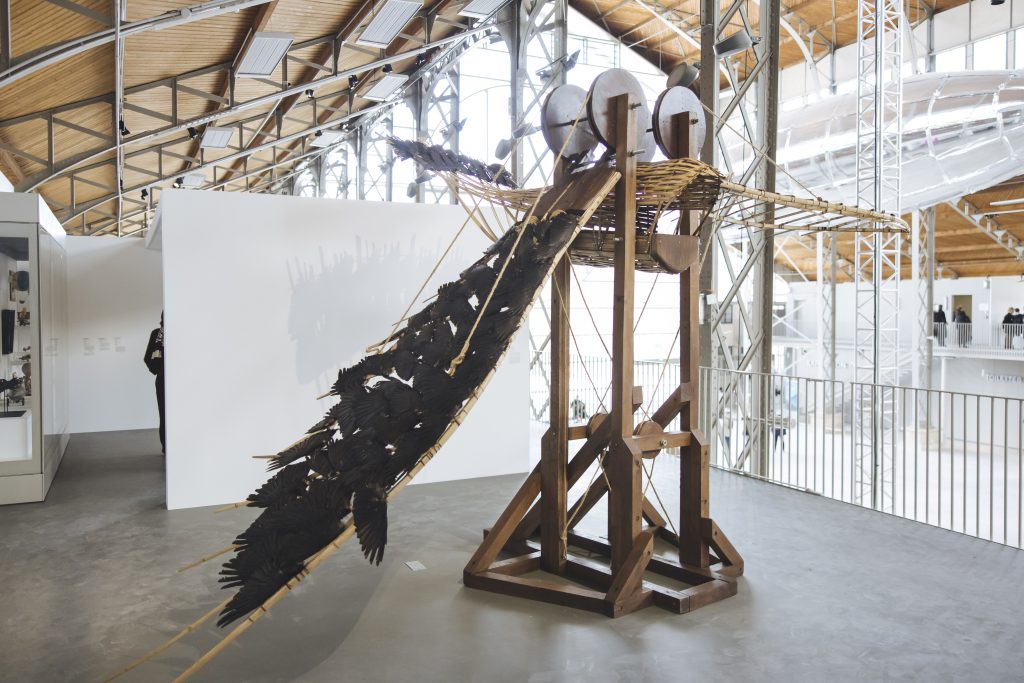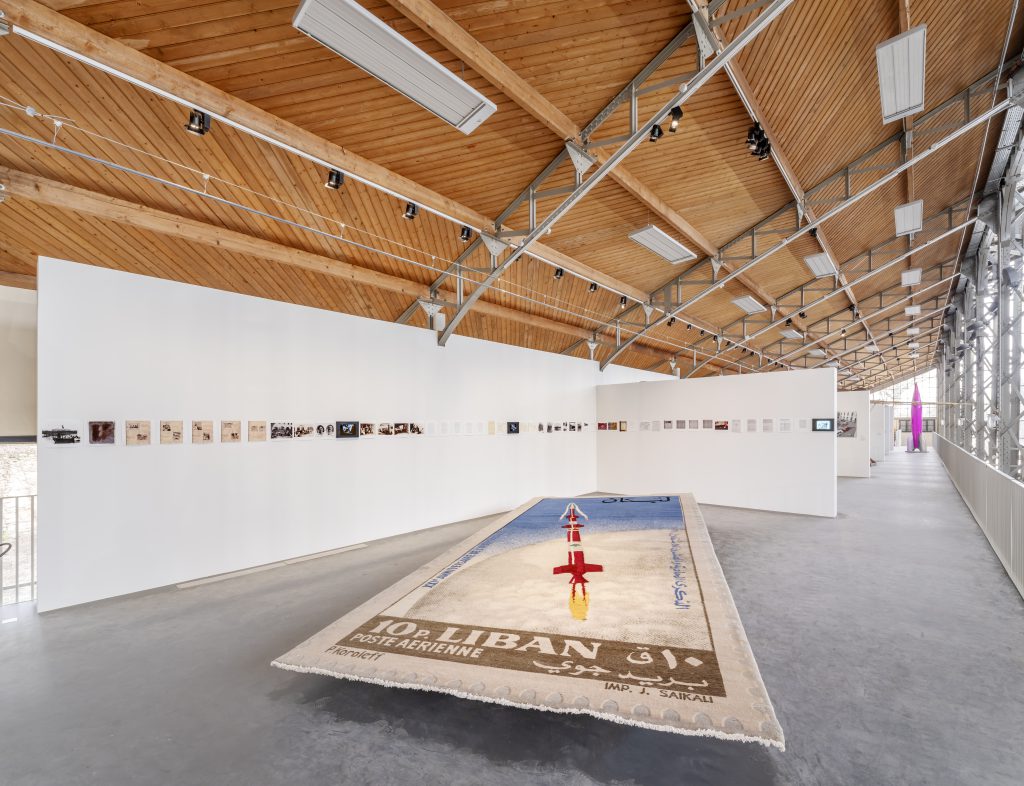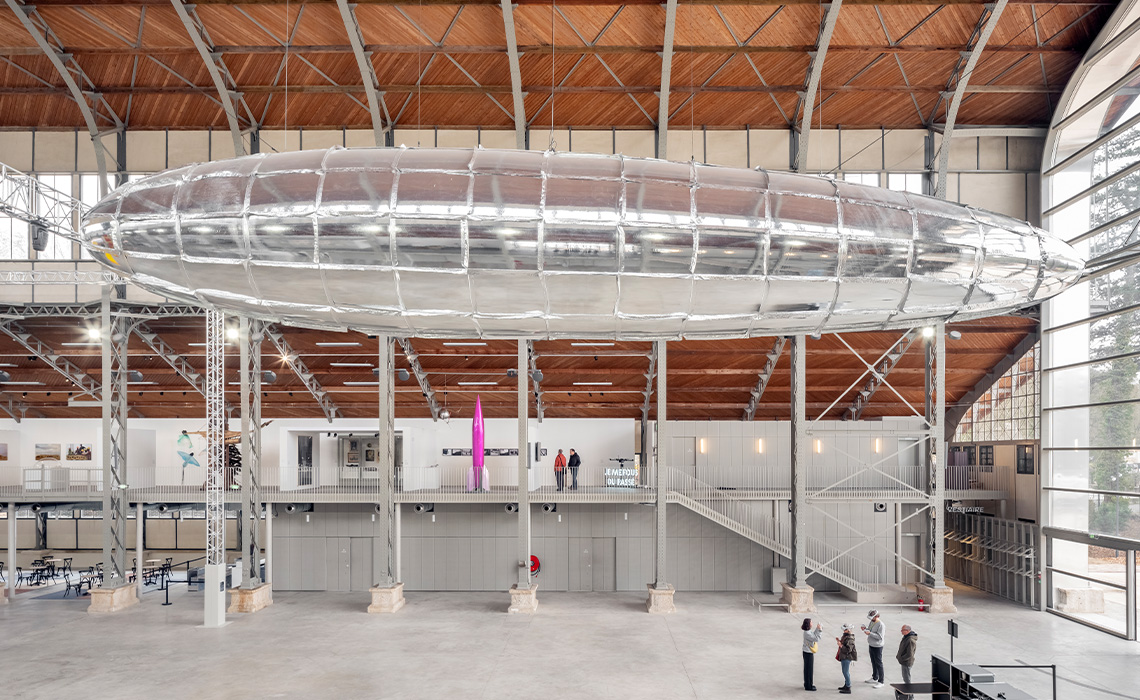Art and the human obsession with flight synchronise through In the air, the flying machines, the opening exhibition at a former centre for pioneering aviation in Paris.
You could see it as an accident of history that modernism and humanity’s successful mastering of machine-powered flight emerged in tandem. Certainly, the period between the Montgolfier brothers’ initial, pioneering balloon experiments and Charles Lindbergh’s first transatlantic flight produced a wealth of cultural and industrial leaps. Few, however, enjoyed quite so obsessive a relationship as the avant-garde and aviation.
‘We must learn to fly through the air, just as we learned how to swim through water and ride a bicycle,’ Vladimir Tatlin wrote in a 1929 manifesto that serves as an intellectual launchpad for In the air, the flying machines, the inaugural exhibition at Hangar Y, a repurposed airship hangar in the Paris suburb of Meudon.
The show brings together a wealth of artistic responses to flight, encompassing everything from 19th century wonder at the potential of new technologies to ominous warnings about aerial terrorism and drone surveillance. Even if the subject matter could hardly fail to interest, the show is an absolute masterclass in thematic, explicitly international exhibition-making.

Initial vitrine displays containing photographs and illustrations of early dirigibles are unexpectedly fascinating. Some of these early flying machines are borderline comedic in appearance: in one instance, we see a distinctly phallic German observation balloon seized by the French army during the First World War, a caption for which informs us that it was gleefully nicknamed “the flying sausage captured from the Boche”. Just as weird are photos of glider pioneer Karl Wilhelm Otto Lilienthal (1848–96) attempting to launch himself into the air with home-made ‘wings’. Absurd as he looks in the picture, such experiments would do much to inform the development of the first aircraft.
Of course, our fascination with flight wasn’t anything unique to the 20th century. We’re reminded that the myth of Daedalus and Icarus had captivated artists for millennia, and in one corner, encounter a facsimile of Leonardo da Vinci’s extraordinary Manuscript B (1487–9), in which the master detailed his plans for a flying machine: in form, if not in terms of practical engineering, it looks remarkably like the planes that would one day be developed by the likes of the Wright brothers and Louis Blériot.
Yet flight’s utopian potential soon calcified into something more sinister. A small 1916 oil painting by British artist Charles Spencelayh depicting a stricken German Zeppelin bursting into flame over the blacked-out London suburbs reduces its subject to a scab of orange and vermilion impasto against a psychedelic sky straight from a Whistler Nocturne. It’s a harbinger of the terror and destruction that aerial bombardment would bring in the decades that followed.
The spectre of aviation’s destructive potential haunts much of the rest of the show, with exhibits ranging from a genuine maquette for Hitler’s dreaded V-1 rocket bomb to Afghan artist Mohammad Hadi Rahnaward’s spectral installation Turning Points (2022). The latter sees a delicate series of mobiles suspended from the ceiling of a darkened room; it takes a while to clock that the shapes are accurate paper models of American aircraft, and that below them, on the floor, is a street plan of war-torn Kabul.
Ahmet Öğüt gives us the flip side to this coin, with a film of Davis-Monthan airbase in Arizona, a desert stronghold that essentially serves as a graveyard for mothballed American military aircraft. Scarier still is Adel Abdessemed’s enormous sculpture of two pigeons with mobile explosive devices strapped to their backs. The work itself may stray into the naffness of street-sculpture territory – but with Abdessemed, who was forced to flee his native Algeria when the savagery of its civil war turned even the most domestic of haunts into death traps, it’s a given that the artist has first-hand knowledge of his depleting message.
Perhaps the single most interesting section of the show comes with a room devoted to Joana Hadjithomas and Khalid Joreige’s A Carpet/The Lebanese Rocket Society Series. The display is dominated by an enormous carpet, onto which has been woven the design for a 1964 Lebanese stamp commemorating both the country’s independence from France and its then-nascent space programme. The latter part of that sentence may sound far-fetched, but no: it really happened.
In the early 1960s, a team of Lebanese engineers successfully launched a number of small rockets into orbit. If the piece, when it was made in 2012, looked like a wistful look back at the bright, pan-Arabist future that at points of the mid-20th century seemed imminent, it now seems altogether more sad; with the economic crisis in Lebanon, and the catastrophe that befell its capital in 2020, it looks further removed from the promise of this not-too-distant past than ever.

Towards the end of the show, however, there are a few moments of humour, albeit ones tainted by airs of paranoia and postcolonial critique. Mircea Cantor’s 2018 film Aquila Non Capit Muscas sees a majestic Carpathian eagle downing and thence destroying a surveillance drone in the Romanian countryside, while Kiluanji Kia Henda’s Icarus 13, The First Journey to the Sun (2007), is a fantastical (and, alas, entirely invented) photographic document of an Angolan rocket launch to our nearest star. The last picture in the series, showing the machine’s supposed re-entry to Earth, is a scene from a Luanda slum street dominated by a vast piece of junked machinery, which we are invited to accept as the debris of this heroic, if explicitly fictional mission.
The exhibition could occasionally do with a bit more curatorial focus: a sub-theme, concentrating on air travel, or aviation and art brut, for example, will be picked up and then mysteriously tail off without explanation. But given the overall quality, the intelligence of the caption texts (in French only for the most part) and general appeal of the wider subject matter, it feels churlish to complain. It’s a fantastic show with a truly universal reach – be sure to catch it if you can.
In the air, the flying machines runs until 10 September 2023



